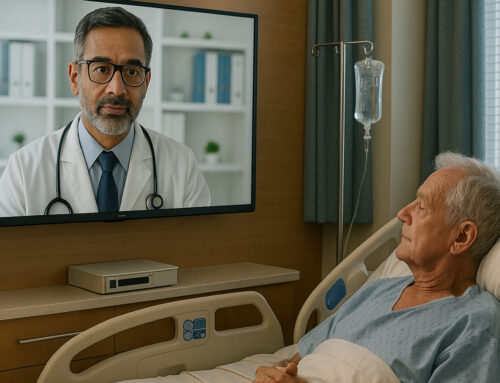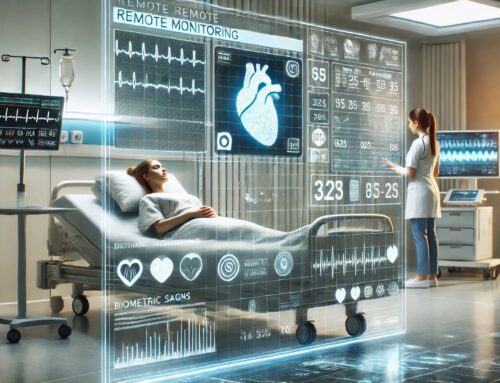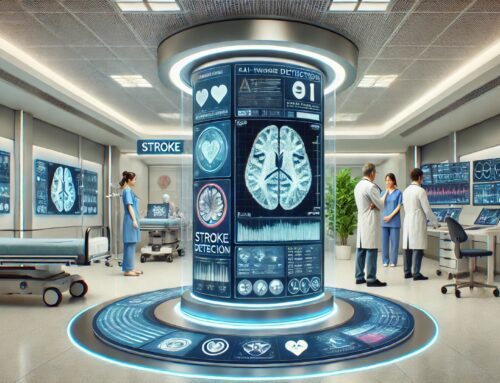- Continuous monitoring using wearable sensors in general hospital wards may help detect patient deterioration earlier than traditional spot check methods and assist clinicians in improving patient outcomes1.
- Wireless monitoring allows earlier patient mobilization, a key indicator for recovery, particularly post-surgery2.
- This innovative technology was developed at GE Healthcare’s global center of excellence for monitoring solutions in Helsinki, Finland.
With most hospitals around the world currently relying on manual “spot-checks” to monitor patient vitals, GE Healthcare unveils Portrait Mobile3, a wireless patient monitoring system that enables continuous monitoring throughout a patient’s stay. The system helps clinicians detect patient deterioration. Early detection of patient deterioration may help reduce length of stay and intensive care unit (ICU) admissions – and improve patient outcomes4. Portrait Mobile includes patient-worn wireless sensors which communicate with a mobile monitor.

Globally, an estimated 65 percent of hospital patients and over 90 percent of post-acute care patients are monitored manually and not continually.5 Many vital sign changes are missed during spot checks which often occur in four-to-six-hour intervals6. A UK national audit of adult in-hospital cardiac arrests showed that more than half (57 percent) occurred on the wards and only five percent in the ICU7 where patients are monitored continuously. Most patients who end up in cardiac arrest or critical care, don’t suddenly deteriorate but rather present with earlier vital signs that show abnormal trends8. Respiratory rate is the highest ranked variable in models predicting clinical deterioration in the hospital9.
With Portrait Mobile, respiration rate, oxygen saturation and pulse rate for general ward and post-surgery patients can be captured wirelessly, continuously. This innovation allows caregivers to identify changes that may signal that cardiorespiratory complications or infectious disease may be developing. It gives clinicians the opportunity to act early and potentially avert serious adverse events.
“In an evaluation clinical study conducted at a London hospital in the UK, 90 percent of nurses reported that they feel more reassured about their patient’s condition when continuous monitoring is used versus vital signs spot check measuring,” said Erno Muuranto, Engineering Director at GE Healthcare in Finland. “Portrait Mobile provides reliable measurement technology and meaningful alarms in a mobile setting.”
For patients, Portrait Mobile’s wireless continuous monitoring helps with the ability to move about the hospital, without being restricted to the bedside. This also allows visitors to interact with the patient without technology getting in the way. Moreover, the solution provides patients and family members peace of mind knowing that monitoring is constant – even when the patient is out of their room. Patient mobility may help improve patient outcomes and reduce length of stay, which may lower costs and elevate patient satisfaction10.
Portrait Mobile is designed to be as reliable as wired technology. Its routable communications architecture enables hospitals to leverage their existing network infrastructure when deploying the system, reducing installation and maintenance costs.
Portrait Mobile was developed in Helsinki, GE Healthcare’s global center of excellence for monitoring solutions where engineers have been developing patient monitoring technology for decades. Today, GE monitors are used in hospitals across the world – from Beijing to London, New York, and more.
About GE Healthcare:
GE Healthcare is the $17.7 billion healthcare business of GE (NYSE: GE). As a leading global medical technology, pharmaceutical diagnostics and digital solutions innovator, GE Healthcare enables clinicians to make faster, more informed decisions through intelligent devices, data analytics, applications and services, supported by its Edison intelligence platform. With over 100 years of healthcare industry experience and around 48,000 employees globally, the company operates at the center of an ecosystem working toward precision health, digitizing healthcare, helping drive productivity and improve outcomes for patients, providers, health systems and researchers around the world.
Follow us on Facebook, LinkedIn, Twitter, Instagram and Insights for the latest news, or visit our website www.gehealthcare.com for more information.
_______________________
1 Taenzer, et al., Postoperative Monitoring—The Dartmouth Experience. The Official Journal of the Anesthesia Patient Safety Foundation; Volume 27, No. 1, 1-28 Circulation 94,429 (2012). 15. Brown, et al., Continuous Monitoring
2 https://www.medelahealthcare.com/en-GB/insights/benefits-of-early-patient-mobilization
3 Portrait Mobile is a CE-marked medical device. Portrait Mobile is not 510(k) cleared and not available in all markets.
4 Brown, et al., Continuous Monitoring in an Inpatient Medical-Surgical Unit: A Controlled Clinical Trial. The American Journal of Medicine; Vol. 127, Issue 3, 226–232. 16. Vincent, et al.,
5 https://www.managedhealthcareexecutive.com/view/need-continuous-monitoring-todays-healthcare-system
6 Michard, et al., Protecting ward patients. ICU Management & Practice; Vol 19 – Issue 1 (2019).
7 Nolan JP, Soar J, Smith GB, et al. (2014) Incidence and outcome of in-hospital cardiac arrest in the United Kingdom national cardiac arrest audit. Resuscitation, 2014; 85:987-92.
8 Churpek MM, Yuen TC, Huber MT, et al. (2012) Predicting cardiac arrest on the wards. A nested case-control study. Chest, 141:1170-1176.
9 Loughlin, et al., Respiratory Rate: The Forgotten Vital Sign – Make It Count! Jt Comm J Qual Patient Saf; 44(8) 494-499 (2018).
10 Vincent, et al., Improving detection of patient deterioration in the general hospital ward environment. Eur J Anaesthesiol; 35:325-333 (2018).
Contacts
Media:
Pernilla Mello
pernilla.mello@ge.com
+44 7766 440153












